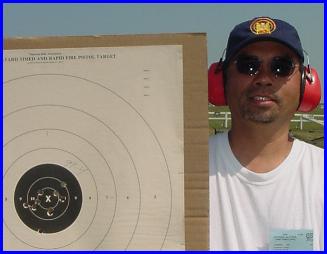
Greetings Shooters,
Brian, a high power rifle shooter from Texas, came to see me for a shooter's eye exam but forgot to bring his Champion shooting glasses for me to evaluate. I had determined an initial shooting glass prescription but I also asked Brian when he returns home to send a side profile picture of him wearing the shooting glasses with a ruler alongside. This was invaluable as I was able to extrapolate the needed information which enabled me to provide Brian with the best possible lens so he would be able to shoot and compete with confidence. Thus, this was my reason for writing about this topic which I believe may help some of our shooters.
Specialized shooting glasses such as the Champions and Knoblochs may be preferred by some of our rifle and pistol shooters. They offer the shooter a variety of options and lens positions. A careful eye examination by your eye care professional may or may not provide optimal vision with these shooting glasses unless they happen to be shooters also.
The distance between the eye and the back surface of the spectacle lens is known as vertex distance. The eye care specialists are well aware that the eyeglass prescription may change when contact lenses are fitted and the Rx may need to be modified. The prescription at the corneal plane (the front surface of the eye) is different than at the plane where the lenses sit on the eyeglass frame. A myopic (nearsighted) eye requires a minus power lens which becomes stronger in power when it is closer. A hyperopic (farsighted) eye needs a plus power lens which becomes weaker.
How does this affect our shooters? The lenses in the Champion, Knobloch and other similar shooting glasses may be positioned two to three times farther than our typical eyeglass frames. Because of this increased distance for some shooters, the lens prescription must be reevaluated. We now have the opposite situation as compared to contact lenses. As the lens is moved out farther from the eye, a minus lens decreases in power and the plus lens increases in power. I had alluded to this ophthalmic principle known as "effective power" in my SHOOTERS' GUIDE FOR THE EYECARE PROFESSIONAL which appeared in the May 2009 issue of Shooting Sports USA. (Ed's Note: Dr Wong's Guide can also be found on this page at: BULLSEYE SHOOTERS' GUIDE FOR THE EYECARE PROFESSIONAL.)
A casual glance at some of the shooters in shooting magazines will show what I'm describing. One may wish to verify the eye-to-lens distance if one uses this style of shooting glasses. Effective power is independent of the age factor, so a 16 year old would experience the same as a 60 year old shooter.
Typical eyeglass vertex distances range from 12mm to 15mm but with the Champion or Knobloch shooting glasses, it may be as far as 40 mm and the effective power may change to an extent that the shooter may not see as intended. Lower power lenses will show a negligible difference and need not be of any concern. However, as the magnitude of the prescription power increases, the new resultant prescription could be 0.25, 0.50 diopter or more in error.
Prescription lenses are fabricated almost exclusively in 0.25 diopter increments but the following table will show how some of you may be affected. Imagine that 25mm is only about an inch. The exact numbers are not as important as the general tendencies the table exhibits. Assume that the shooting glass lens is farther than your normal eyeglass lens by 15mm, 20mm, 25mm and 30mm, the effective power changes as follows:
| Your Rx: | ||||
To the best of my knowledge, the above is the first and only table of this kind, specifically for the benefit of shooters in mind. By understanding how vertex distance may affect some of our shooting glass prescriptions, we can use this to our advantage, as I do in my practice. If you see just fine when shooting, there's no need for any concern, but if you don't, vertex distance may be a contributing factor for an error in your prescription. If you see fine but your eyes fatigue as the shooting day progresses, again, consider vertex distance.
For example, a 4.00 diopter lens with an increase of 30mm vertex distance will change by about 0.50 diopter. For a plus lens, it becomes +4.55 diopters. For a minus lens, it becomes -3.57 diopters. The target may seem distractingly blurred for rifle shooters. For iron sights pistol shooters, the bull may be more blurred than tolerable. Pistol shooters using red dot scopes may wonder why the dot is not round and clear.
This difference in power may be perfectly fine if this was the intended and desired result, but most likely, vertex distance was probably overlooked. Keep in mind that a 90 degree offset lens bar holder may be available to bring the lens closer to the eye, but it may be limited to the brand, model, and lens diameter. I've also noted that some shooters prefer rotating this 90 degree lens bar holder the opposite direction to place the lens farther away from the eye.
If after referring to the table, the vertex distance does not appear to be the cause of one's vision problems, then other factors must be considered. There is the possibility of unstable vision due to poor medical health as with Diabetes, pathology associated with the aging eye, side effects from medications, and an incorrect shooting glass prescription.
An interesting note to consider; a +0.50 diopter lens used on the front sights on certain rifles to provide magnification no longer behaves as a +0.50 diopter power lens to our eyes because of vertex distance. The effective power becomes higher.
Good Vision and Good Shooting to All,
Norman H. Wong, O.D.
